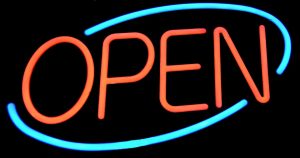The very word evokes a sense of happiness and possibility.
When you’re hungry at an odd hour and everything around you seems to be closed, that lone neon sign glowing in a restaurant window is a most welcome relief.
When a shop or service you’ve longed for finally builds a branch in your neighborhood, you count the days until it opens.
And when you’re solving a tough analytics problem, “open” is what you want and need your software to be.
Now, sometimes people confuse “open” and “open source,” but of the two, open is a much bigger concept. To be open simply means to be accessible. Unlocked. Ready to work with all customers who walk through the door. And that’s what SAS is doing. We are:
- Open to all analytics problems.
- Open to all users.
- Open to all skill sets.
- Open to all sizes and scales.
- Open to all IT environments.
A tradition of openness
Being open isn’t new for SAS. Early in our development, we made a choice to design our software to run across all platforms. By making it incredibly easy for data to flow to our software from any source, we positioned our customers to be ready for advancements like Hadoop and the cloud, as soon as those things came to be.
So SAS® Viya™ is really just an extension of that core philosophy. Our newest platform greets open source software with a wide and welcoming embrace because we understand that the very best breakthroughs are collaborative. SAS Viya takes a community-based approach to analytics. Its multilingual capability provides a low-cost entry point for testing analytical processes and concepts. It also opens up the talent pool of people who can work on your analytics challenges.
But we haven’t stopped there. SAS 9.4 has these features, too, because we recognize that all our customers need the open advantage – even if they aren’t ready to migrate to a new platform. Now all our customers can enjoy the governance and the ability to scale that’s previously been missing in the open source world.
Why be open?
So what’s the value to you? In a competitive climate, winning means assembling the best team you can find, people with complementary skills and talents, and equipping them with multiple avenues for getting the job done. It also means taking a look at your solutions and finding the optimal balance of governance, cost, scalability, flexibility, depth and breadth.
When I look at how organizations are using analytics, I notice that extremes (all open source, or all proprietary software) rarely bring the biggest wins. In the most elegant solutions, balance is where it’s at. As we work to extend the benefits of many third-party technologies, including open source, we’re pleased and proud to have our open sign lit, ready to serve all comers.


